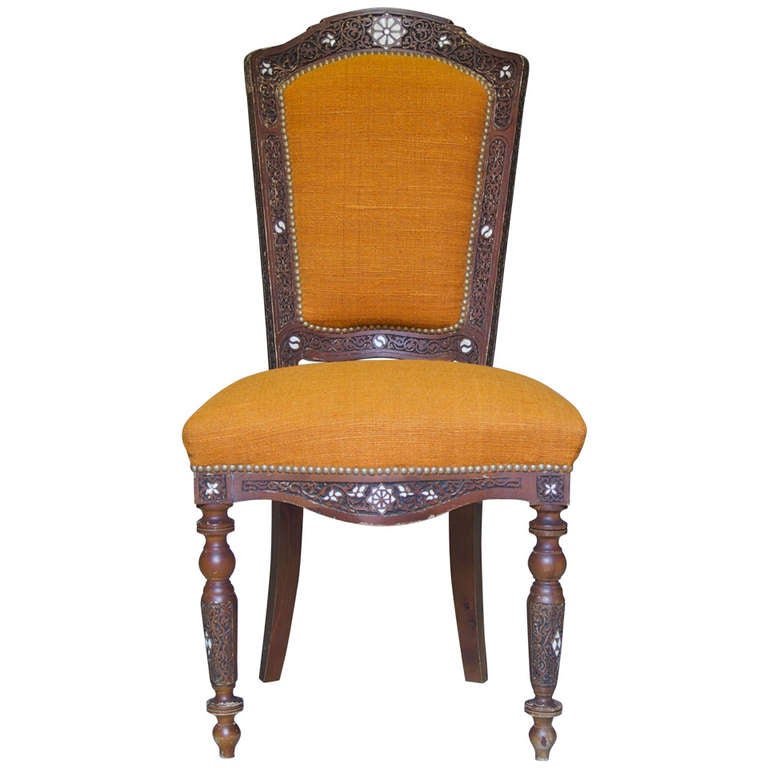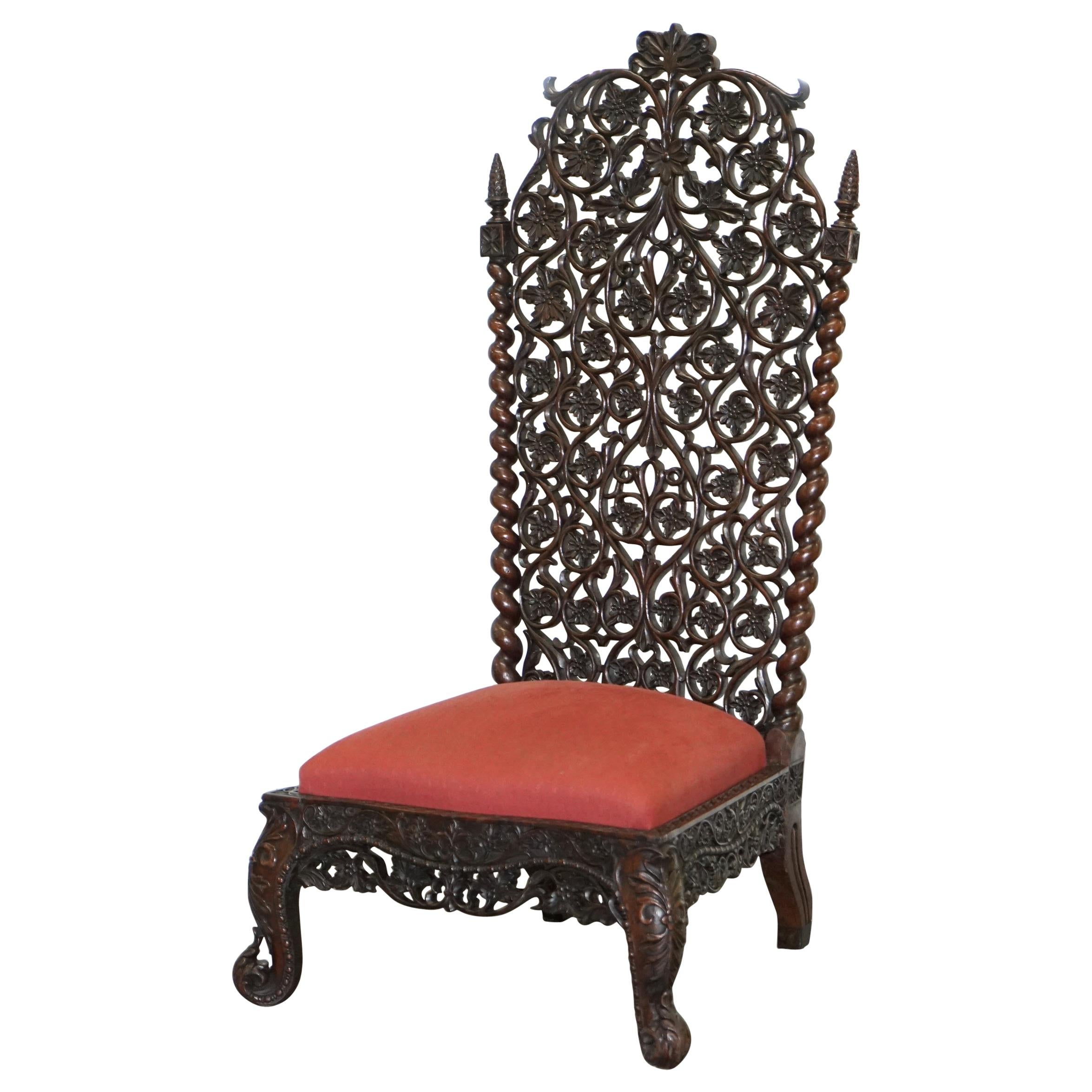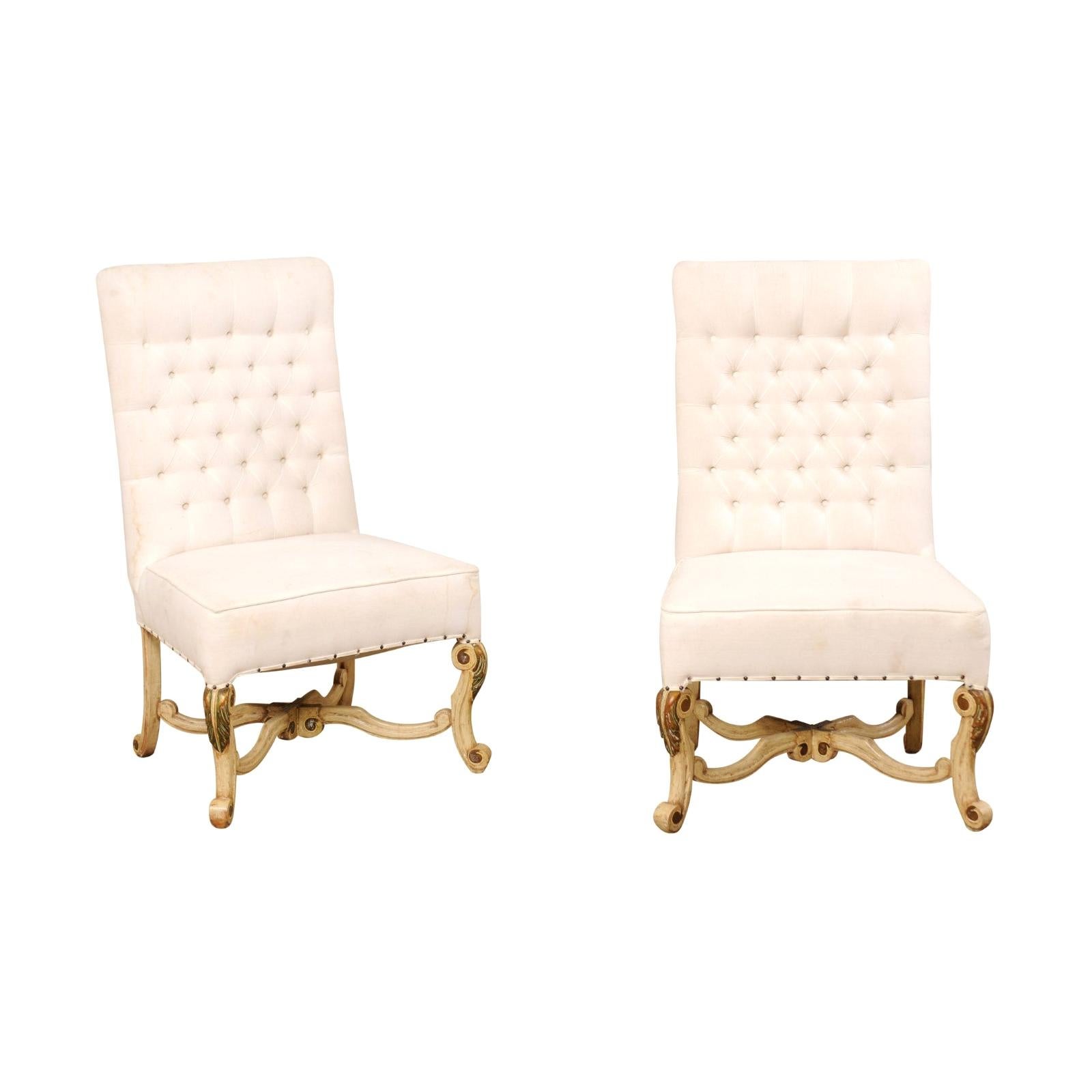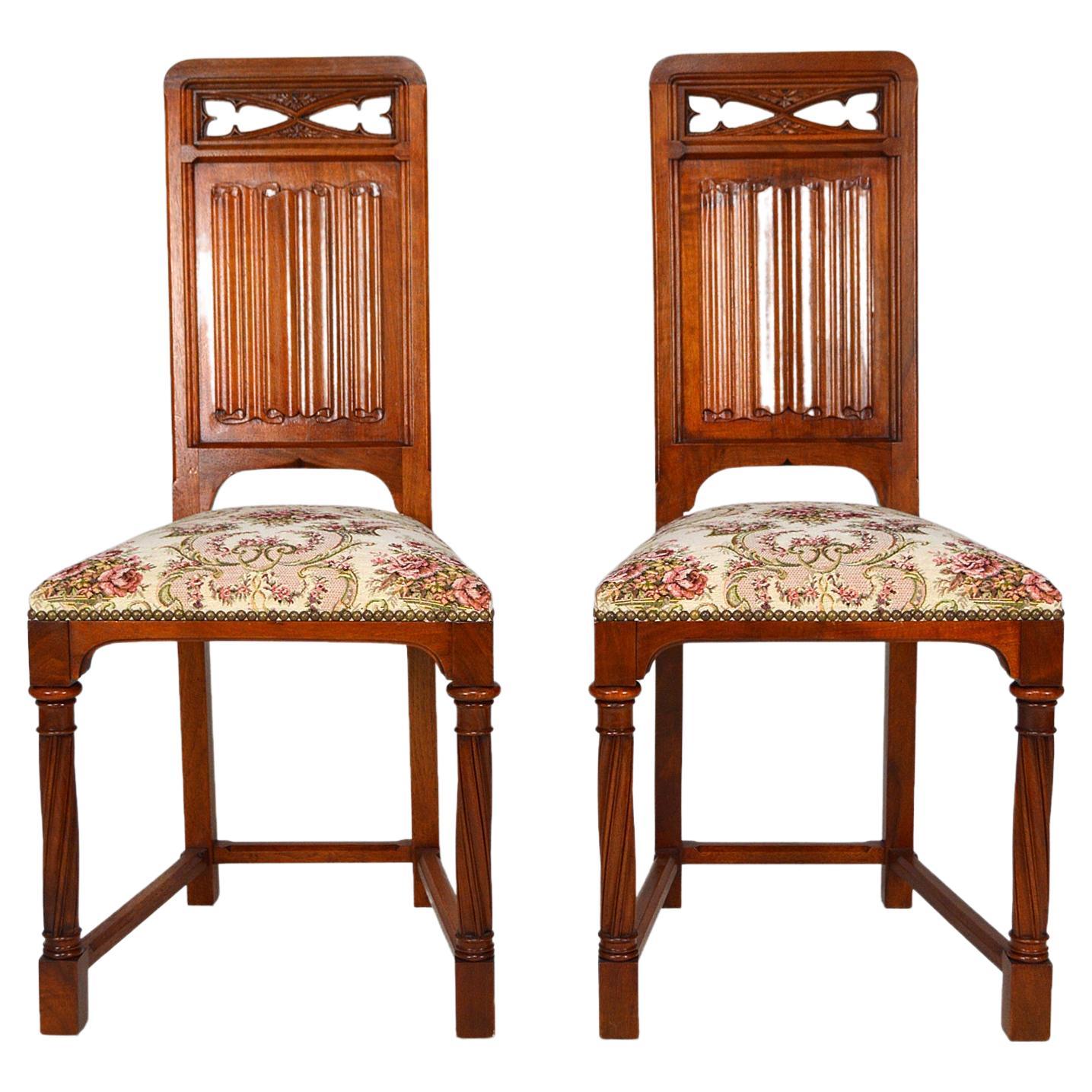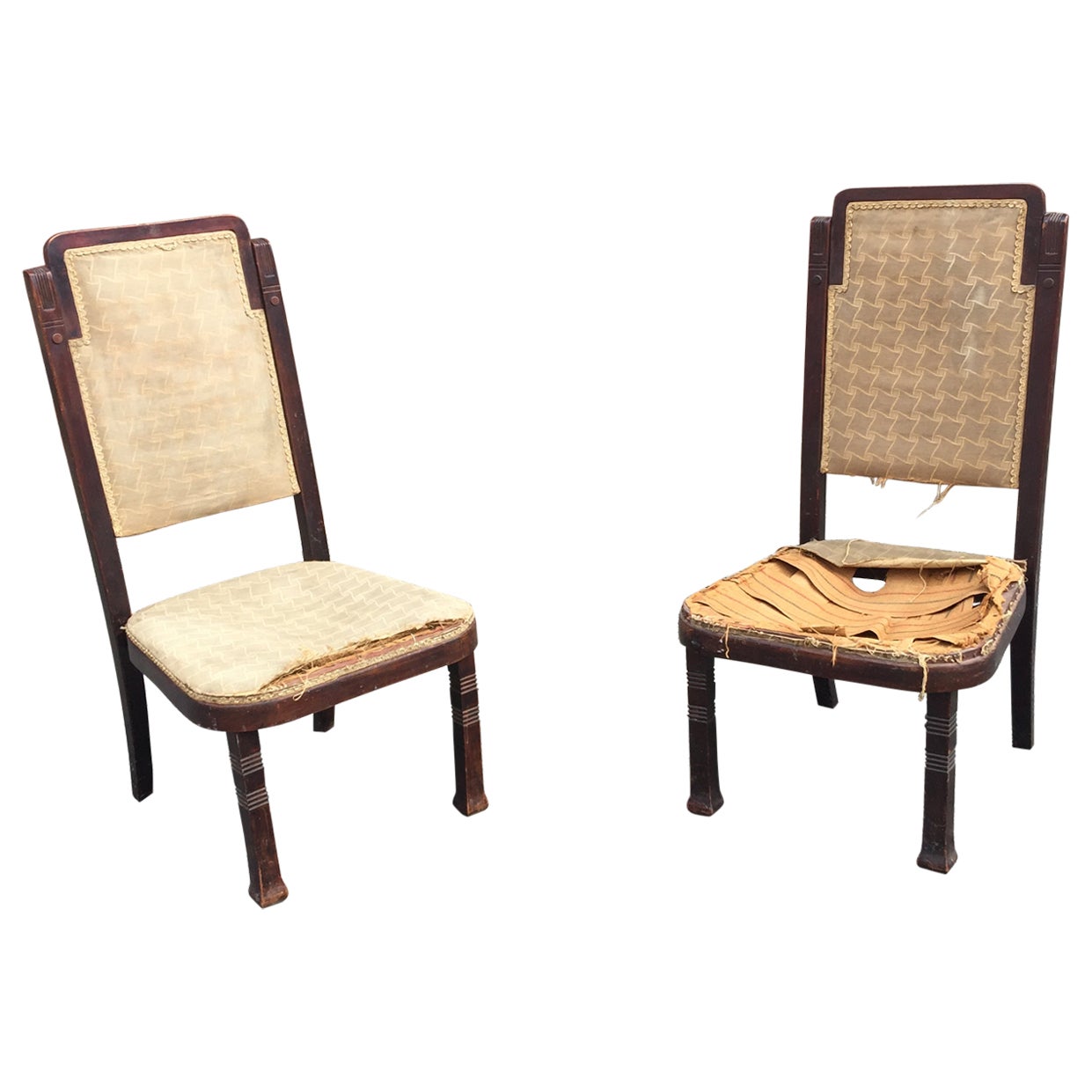Items Similar to Rare Pair of circa 1900 Tibetan Ceremonial Chairs Nyingma Buddha Carved in Backs
Want more images or videos?
Request additional images or videos from the seller
1 of 21
Rare Pair of circa 1900 Tibetan Ceremonial Chairs Nyingma Buddha Carved in Backs
About the Item
We are delighted to offer for sale this extremely rare pair of original circa 1900 Tibetan Ceremonial chairs with gold gilt decoration and large cast figures of the Buddhist god Nyingma
Where to begin! Wow, what a pair of large and important ceremonial chairs! They are very naively hand made but quite exquisite in their detail. The fronts depict peacocks and lots of floral detailing all of which is premium real gold gilt. The backs have the meditating figures of the Buddhist god Nyingma
In terms of the condition they are circa 120 years old and absolutely solid, as such they have patina marks here and there as you would expect. Really, they are just a stunning pair of spiritual chairs that will define a space in a powerful way
Dimensions:
Height 115cm
Width 58cm
Depth 66cm
Seat height 66cm frame only not including the cushion
Please note all measurements are taken at the widest point
The Nyingma tradition is the oldest of the four major schools of Tibetan Buddhism (the other three being the Kagyu, Sakya and Gelug). "Nyingma" literally means "ancient," and is often referred to as Ngangyur (IPA: [?a??u?], Tibetan: ????????????????, Wylie: snga 'gyur rnying ma, "school of the ancient translations" or "old school") because it is founded on the first translations of Buddhist scriptures from Sanskrit into Old Tibetan in the eighth century. The Tibetan alphabet and grammar was created for this endeavour.
The Nyingma particularly believes in hidden terma treasures and place an emphasis on Dzogchen. They also incorporate local religious practices and local deities and elements of shamanism, some of which it shares with Bon. The Nyingma tradition actually comprises several distinct lineages that all trace their origins to the Indian master Padmasambhava.
Traditionally, Nyingmapa practice was advanced orally among a loose network of lay practitioners. Monasteries with celibate monks and nuns, along with the practice of reincarnated spiritual leaders, are later adaptations. In modern times, the Nyingma lineage has been centered in Kham and has been associated with the Rimé movement.
Mythos
Traditional Nyingma texts see themselves as a lineage which was established by Samantabhadra (Güntu Sangpo), the “primordial buddha” (Adi Buddha) and who is also the embodiment of the Dharmakaya, the "truth body" of all buddhas. Nyingma also sees Vajradhara (an emanation of Samantabhadra) and other buddhas as teachers of their many doctrines. Samantabhadra's wisdom and compassion spontaneously radiates myriad teachings, all appropriate to the capacities of different beings and entrusts them to "knowledge holders" (vidyadharas), the chief of which is Dorjé Chörap, who gives them to Vajrasattva and the dakini Légi Wangmoché, who in turn disseminate them among human siddhas.[3] The first human teacher of the tradition was said to be Garab Dorje (b. 55 c.e.), who had visions of Vajrasattva. Padmasambhava is the most famous and revered figure of the early human teachers and there are many legends about him, making it difficult to separate history from myth.
Other early teachers include Vimalamitra, Jambel Shé Nyen, Sri Simha, and Jñanasutra. Most of these figures are associated with the Indian region of Oddiyana. Historical origins Buddhism existed in Tibet at least from the time of king Thothori Nyantsen (fl.173?-300? CE), especially in the eastern regions.[4] The reign of Songtsen Gampo (ca.617-649/50) saw an expansion of Tibetan power, the adoption of a writing system and promotion of Buddhism. Around 760, Trisong
Detsen invited Padmasambhava and the Nalanda abbot Santarak?ita to Tibet to introduce Buddhism to the "Land of Snows." Trisong Detsen ordered the translation of all Buddhist texts into Tibetan.
Padmasambhava, Santarak?ita, 108 translators, and 25 of Padmasambhava's nearest disciples worked for many years in a gigantic translation-project. The translations from this period formed the base for the large scriptural transmission of Dharma teachings into Tibet and are known as the "Old Translations". Padmasambhava supervised mainly the translation of tantras; Santarak?ita concentrated on the sutras.
Padmasambhava and Santarak?ita also founded the first Buddhist monastery in Tibet: Samye. However, this situation would not last: The explosive developments were interrupted in the mid-ninth century as the Empire began to disintegrate, leading to a century-long interim of civil war and decentralization about which we know relatively little.
The early Vajrayana that was transmitted from India to Tibet may be differentiated by the specific term "Mantrayana" (Wylie: sngags kyi theg pa). "Mantrayana" is the Sanskrit of what became rendered in Tibetan as "Secret Mantra" (Wylie: gsang sngags): this is the self-identifying term employed in the earliest literature.
Persecution
Part of the Dzogchen text The cuckoo of awareness, from Dunhuang. From this basis, Vajrayana was established in its entirety in Tibet. From the eighth until the eleventh century, this textual tradition (which was later identified as 'Nyingma') was the only form of Buddhism in Tibet. With the reign of King Langdarma (836–842), the brother of King Ralpachen, a time of political instability ensued which continued over the next 300 years, during which time Buddhism was persecuted and largely forced underground because the King saw it as a threat to the indigenous Bön tradition. Langdarma persecuted monks and nuns, and attempted to wipe out Buddhism. His efforts, however, were not successful.
A few monks escaped to Amdo in the northeast of Tibet, where they preserved the lineage of monastic ordination. The period of the 9-10th centuries also saw increasing popularity of a new class of texts which would later be classified as the Dzogchen "Mind series" (Semde). Some of these texts present themselves as translations of Indian works, though according to David Germano, most are original Tibetan compositions. These texts promote the view that true nature of the mind is empty and luminous and seem to reject traditional forms of practice.[8] An emphasis on the Dzogchen textual tradition is a central feature of the Nyingma school.
This item is available for collection from our Wimbledon warehouses
Condition:
Please view the very detailed pictures as they form part of the description around condition
Please note vintage period and original items such as leather seating will always have natural patina in the form of cracking creasing and wear, we recommend regular waxing to ensure no moisture is lost, also hand dyed leather is not recommended to sit in direct sunlight for prolonged periods of time as it will dry out and fade.
- Dimensions:Height: 45.28 in (115 cm)Width: 22.84 in (58 cm)Depth: 25.99 in (66 cm)Seat Height: 25.99 in (66 cm)
- Sold As:Set of 2
- Style:Edwardian (Of the Period)
- Materials and Techniques:
- Place of Origin:Tibet
- Period:1900-1909
- Date of Manufacture:1900
- Condition:Wear consistent with age and use. Minor fading.
- Seller Location:GB
- Reference Number:1stDibs: LU2823319570452
About the Seller
4.6
Gold Seller
These expertly vetted sellers are highly rated and consistently exceed customer expectations.
Established in 2012
1stDibs seller since 2017
1,716 sales on 1stDibs
Typical response time: <1 hour
- ShippingRetrieving quote...Ships From: United Kingdom
- Return PolicyA return for this item may be initiated within 14 days of delivery.
More From This SellerView All
- Rare circa 1880 Burmese Solid Hardwood Hand Carved Floral Chair High Back OrnateLocated in GBWe are delighted to this absolutely stunning solid Rosewood hand carved high back low seat Burmese chair A truly stunning piece, this type of furniture is just about as ornate as ...Category
Antique 1880s Burmese Victorian Side Chairs
MaterialsHardwood
- Pair of circa 1840 Hand Carved Prie Dieu High Back Prayer Chairs Original BasesLocated in GBWe are delighted to offer for sale this stunning pair of early 19th century Prie Dieu chairs made with solid walnut frames and the original thatched sears A great pair of occasion...Category
Antique 1840s English Early Victorian Side Chairs
MaterialsWalnut
- Rare Pair of Thomas Chippendale Period 1760 Embroidered Chairs Ornately CarvedBy Thomas Chippendale Jr., Thomas ChippendaleLocated in GBWe are delighted to this very rare pair of Thomas Chippendale era circa 1760 Library chairs with period embroidered upholstery These are a very rare and highly collectible pair of Library chairs, they were made in the Chippendale era and closely after his designs, the fret work carving, ornate legs, all very finely executed by a master craftsman The upholstery is all original embroidery, the colours are very much of the period and not seen on later reproduction pieces. These are an exceptional example and would be highly prized in any collection The chairs have been lightly restored to include some work to the carvings, the timber has been sympathetically French polished to ensure none of the original charm and patina has been lost A period pair of Chippendales by the great man himself (which these could be) would retail for the high hundreds of thousands, however alas Chippendales are only originals if they come with iron clad provenance, a difficult thing to keep hold of for nearly 250 years. One of the chairs has a plaque to the base for Charles Tozer of 25 Brook street London, Mr Tozer was a very well respected Antiques dealer in the early 20th to mid 20th century that specialised in 18th century furniture Dimensions: Height 97cm Width 64cm Depth 65cm Please note all measurements are taken at the widest point Thomas Chippendale (1718–1779) was born in Otley in the West Riding of Yorkshire, England in June 1718. He became a cabinet-maker in London, designing furniture in the mid-Georgian, English Rococo, and Neoclassical styles. In 1754 he published a book of his designs, titled The Gentleman and Cabinet Maker's Director, upon which success he became renowned. The designs are regarded as representing the current British fashion for furniture of that period and are now reproduced globally. He was buried 16 November 1779, according to the records of St Martin-in-the-Fields, in the cemetery since built upon by the National Gallery. Chippendale furniture is much valued; a padouk cabinet that was offered for auction during 2008 sold for £2,729,250. Life "A Design for a State Bed" from the Director, 1762. Chippendale was born the only child of John Chippendale (1690–1768), joiner, and his first wife Mary (née Drake) (1693–1729). He received an elementary education at Prince Henry's Grammar School. The Chippendale family had long been involved with the wood working trades and so he probably received his basic training from his father, though it is believed that he was also trained by Richard Wood in York, before he relocated to London. Wood later ordered eight copies of the Director. On 19 May 1748 he married Catherine Redshaw at St George's Chapel, Mayfair and they had five sons and four daughters. During 1749 Chippendale rented a modest house in Conduit Court, near Covent Garden. In 1752 he relocated to Somerset Court, off the Strand. In 1754 Chippendale relocated to 60–62 St Martin's Lane in London, where for the next 60 years the family business operated, until 1813 when his son, Thomas Chippendale (Junior), was evicted for bankruptcy. During 1754 he also began a partnership with James Rannie, a wealthy Scottish merchant, who put money into the business at the same time as Chippendale produced the first edition of the Director. Rannie and his bookkeeper, Thomas Haig, probably cared for the finances of the business. His wife, Catherine, died during 1772. After James Rannie died in 1766, Thomas Haig seems to have borrowed £2,000 from Rannie's widow, which he used to become Chippendale's partner. One of Rannie's executors, Henry Ferguson...Category
Antique 1760s English Georgian Side Chairs
MaterialsUpholstery, Hardwood
- Antique Hand Carved High Back Chair Embossed Painted Armorial Crest Coat of ArmsLocated in GBWe are delighted to offer this lovely antique hand carved throne chair with embossed hand painted coat of arms to the back and Knights helmet to the top What a chair! This is a fi...Category
Antique 19th Century English Jacobean Side Chairs
MaterialsLeather, Wood
- Fine circa 1780 Georgian Shell Back Hall Chair Gillows of Lancaster AttributedBy Gillows of Lancaster & LondonLocated in GBWe are delighted to offer for sale this lovely Georgian circa 1780 Cuban mahogany hall chair attributed to Gillows of Lancaster A very fine Georgian chair, clearly made by Gillows however as its not stamped we have classed it as attributed to. The piece has all the normal master craftsman details, the recessed back handle, the very fine carved back rest, this piece just screams understated English fine...Category
Antique 1780s English Georgian Side Chairs
MaterialsHardwood
- Very Rare Pair of Hermes Paris Cherrywood Chairs Luxury PremiumBy HermèsLocated in GBWe are delighted to this one of a kind pair of custom made Hermes Paris Cherry wood chairs with the H back rests RRP £22,000 These are the only c...Category
21st Century and Contemporary French Modern Chairs
MaterialsVelvet, Cherry
You May Also Like
- Elaborately Carved Oriental Side Chair, Circa 1900Located in Isle Sur La Sorgue, VaucluseBeautifully carved side chair, with mother-of-pearl inlays, newly upholstered in vintage wool.Category
Early 20th Century Chairs
- Pair of High Back Chairs with Tufted Backs and Nicely Carved LegsLocated in Atlanta, GAA pair of vintage American upholstered chairs with nicely carved legs and stretcher. This pair of good-sized, arm-less side chairs have an Italian inspired design, with each featurin...Category
20th Century American Chairs
MaterialsMetal
- Pair of Gothic Revival Chairs in Carved Walnut, France, circa 1890Located in VÉZELAY, FRPair of caquetoire / side chairs in walnut with carved scroll backs, and beige and pink floral patterned fabric. Neo / Revival Gothic Renaissance style, France, around 1890. St...Category
Antique 1890s French Gothic Revival Chairs
MaterialsFabric, Wood, Walnut
- Rare Pair of Vienna Secession Chairs, circa 1880By Thonet, J.&J. Khon 1Located in Mouscron, WHTRare pair of Vienna Secession chairs circa 1880.Category
Antique Late 19th Century Vienna Secession Side Chairs
MaterialsBeech
- 1940s Carved Ladder Back Needlepoint Seat Chairs, A pairLocated in Germantown, MD1940s Carved Ladder Back Needlepoint Seat Chairs. Good vintage condition. Needlepoint upholstery seat in good condition. Measures 17"W x 19.5"D...Category
Mid-20th Century American Mid-Century Modern Chairs
MaterialsFabric, Upholstery
- Rare and Important Pair of Dutch Colonial Carved Side ChairsLocated in Bridgeport, CTThe ebonized chairs with shaped and carved crest rails with leaves and center fruit basket motifs. The barley twist side supports with carved flower...Category
Antique 19th Century Dutch Colonial Side Chairs
MaterialsEbony
Recently Viewed
View AllMore Ways To Browse
Pair Of Rare Chairs
Rare Vintage Chairs
Rare Antique Chairs
Rare Antique Chair
Carved Wood Back Of A Chair
Circa 1900 Chair
Long Back Chair
Antique Furniture Identifier
Hand Carved Chair Frames
Large Carved Chair
Formed Wood Chair Pair
All Hand Carved Chairs
Lot Of Chairs
Chair No Cushions
Used Chairs Lot
Antique Chair With Cushioned Seat
Floral Back Chairs
Antique Chair Part
